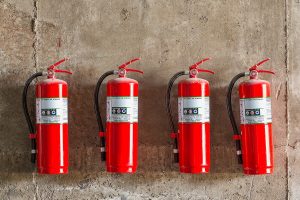
A fire in your business will probably start small. That means your employees should be able to deal with it, but only if they can reach portable fire extinguishers stationed around your premises.
A fire in your business will probably start small. That means your employees should be able to deal with it, but only if they can reach portable fire extinguishers stationed around your premises. Here’s what you’ve got to know.
OSHA Standards
All portable fire extinguishers need to be approved by a certified tester, such as the Underwriters’ Laboratory, in order to meet OSHA standards. These extinguishers also need to match the type of fire you can expect to break out, depending on what your business does. Moreover, these extinguishers need to be where your employees can get to them quickly. They need to be big enough, and you need to have enough of them on hand. Make sure that all of your extinguishers can pass the necessary inspections and that you give your employees (or at least certain ones) the training to use them properly.
Different Classes
Class A: For ordinary materials that can catch on fire, such as wood, paper, and plastic.
Class B: For flammable liquids and gas fires, such as those from gasoline and oil.
Class C: For electrical fires and electrical equipment that need non-conductive extinguishing agents.
Class D: For metals that can combust, such as magnesium or sodium. These are used when metal is burning and cannot react with whatever fire suppression agent you use on it, which could only make the fire worse.
Class K: To fight fires in your commercial kitchen, be sure to include class K portable fire extinguishers. These can put grease fires, cooking oil fires, and fires caused by cooking fats.
Placement
Your portable fire extinguishers must meet OSHA standards. Part of meeting these standards involves placing fire extinguishers where they should be needed the most. Think about how far away the closest fire extinguisher is and how much square footage separates two individual units.
Labels
You also need to ensure that the labels are clear and easy to read. Pictures and instructions are on these labels to make them as descriptive to the operators as possible. Having an easy-to-read label is essential, especially since the person who picks it up can panic and forget their training on how to use it correctly without hurting themselves or others around them.
Commercial and Residential Fire Prevention from Judd Fire Protection
If you want to ensure your home and business are safe throughout the year, trust Judd Fire Protection, LLC. We have over two decades of experience in designing, installing, inspecting, and repairing residential and commercial fire protection systems. We serve clients throughout Maryland, Pennsylvania, Washington, D.C., Virginia, and West Virginia. If you are interested in finding out more about our services and protecting your home and business, give us a call at 410-871-3480 or contact us online. For more fire safety tips, follow us on Facebook, Twitter, and Pinterest.
